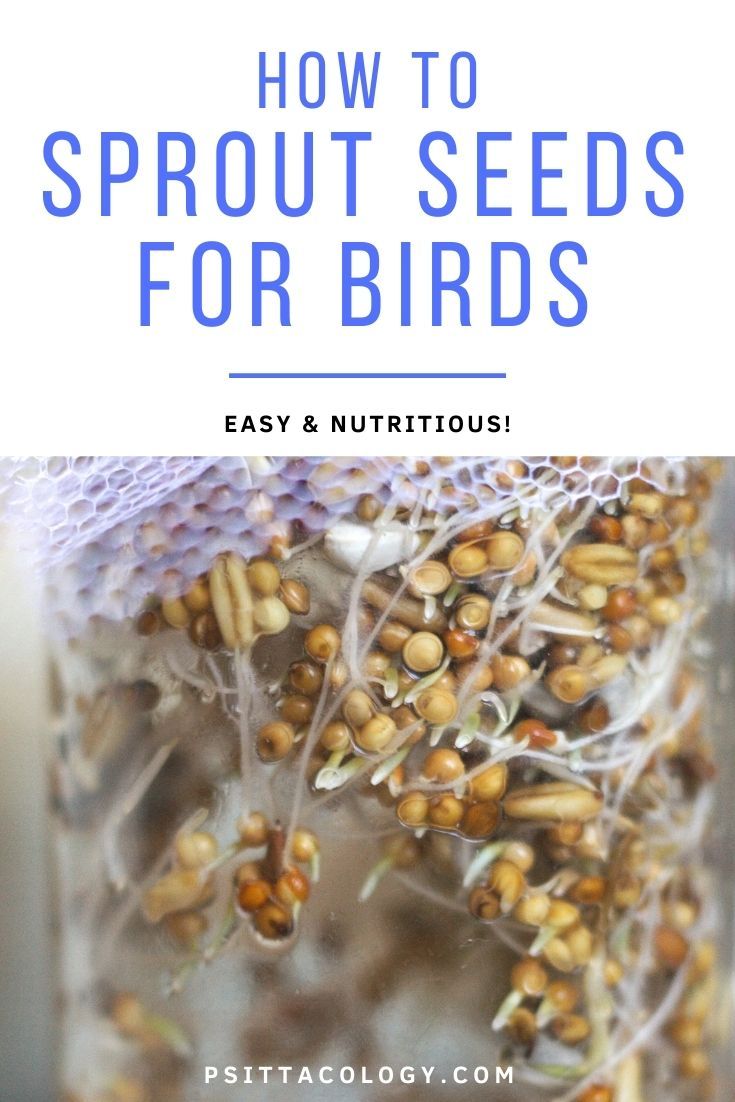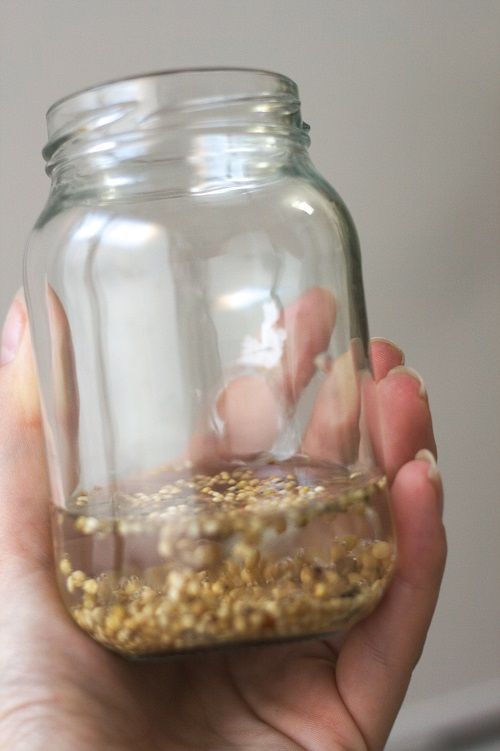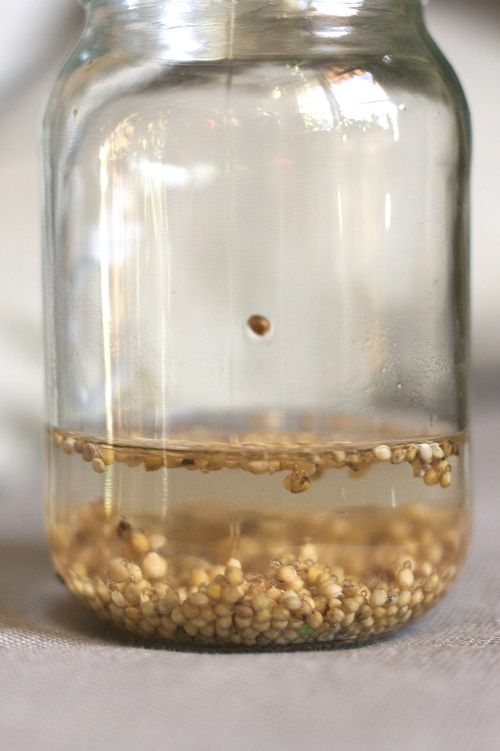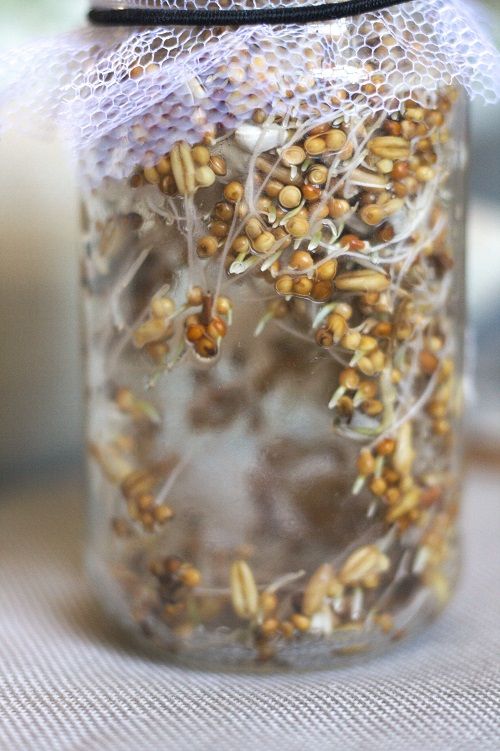Figuring out the right diet for your parrot can be challenging. Seed mixes are the traditional choice, but as mentioned in the article on parrot diet, they’re not ideal as a staple. Pellet quality varies wildly and some feel they’re unnatural. You can make parrot chop, but did you know there’s another great option?
Sprouting seeds for birds like parrots is a breeze and vastly increases the nutritional value of normal seed mixes. Perfect as a healthy alternative to dried seeds!
Keep reading for everything you need to know about sprouting seeds for birds and why you should be doing it.
This post contains affiliate links. If you make a purchase, a small percentage will go directly to Psittacology at no additional cost to you. Thank you for supporting Psittacology!
Sprouting seeds for birds: Why should you do it?
You probably have eaten sprouts and/or sprouted seeds before. I’m pretty sure we all sprouted beans in wet kitchen paper or cotton when we were in primary school! Alfalfa and mung bean sprouts have always been popular. Recent health crazes brought the introduction of more ‘unusual’ sprouts, like cilantro, radish, and wheatgrass.
Whether you like some sprouts in your salad or not, no one can deny they’re good for you. And their benefits aren’t just limited to us humans: they’re great for our feathered friends as well.
Dried vs. sprouted seeds
You see, the thing is, most traditional parrot seed mixes are dried, uniform and high in fat. This doesn’t really reflect a wild parrot’s diet, as they’d eat seeds in all their stages – fresh, dried, sprouted. It’s also too calorie-rich for our indoor birds, which don’t move around enough to justify such a high-fat diet.
Still, especially with small seed eaters like budgies and cockatiels, it’s difficult to deny them their favorite food. They just love seeds! That’s where sprouts come in. Their nutritional profile is much better than dried seeds, but they’re still similar enough that most parrots will give them a try without too much effort.
So what’s all the fuss about? Why are sprouted seeds supposedly so much better for your bird? According to a 2010 review of sprouts and their health benefits:
- Dry seeds contain stored fat meant to kickstart a sprout. Once the sprouting process is on the way, the fat content plummets and the protein content increases.
- The amount of healthy amino acids goes up during sprouting, as does the vitamin content (notably vitamin C).
- The mineral content stays the same, but the minerals in question are better utilized, meaning sprouts are more nutritious.
- Speaking of better utilization: sprouts in general are easier to digest and their nutrients absorbed better. They’re even perfect for weaning baby birds, as they’re softer than dried seeds.

Sprouting seeds for birds: What do you need?
Jar
There are a few sprouting methods, like sprouting in soil or on wet cotton/kitchen paper. The easiest method to sprout seeds for bird (and human!) consumption, though, is the sprouting jar method.
It involves:
- A large, clean, transparent jar. In the photos in this article, I used an old mayonnaise jar and an old pesto jar (after somebirdy broke the mayo one).
- A square of mesh or breathable fabric like pantyhose or cheesecloth that will allow water to pass through.
- A rubber band to fasten the cover.
If you plan on sprouting seeds regularly, you can also opt for the “professional” version and get a seed sprouting kit. They come with a handy lid and a stand, making everything a bit easier.
- INEXPENSIVE ORGANIC FOOD AT HOME: Are you tired of…
- CONVENIENT & VERSATILE: The wide mouth jars allow…
- FOOD GRADE & DURABLE MATERIAL: The sprouting lids…
- EASY TO SPROUT SEEDS: Start sprouting seeds now!…
- DELICIOUS AND FUN: Sprouts are highly delicious…
Seeds
Time to select seeds to sprout! And here’s the kicker: almost anything sprouts. In most of the photos in this post I’m using a millet-heavy small parrot seed mix without any added pellets (those would just rot).
If you don’t have any birdseed lying around, though, you probably still won’t have to run out to the shops. Just raid your cupboards to see if you have one of the following:
- Legumes: Lentils, beans (except for kidney beans), chickpeas, mung beans
- Seeds (you may have some of these in your spice rack or garden shed): Broccoli, radish, fenugreek, mustard, clover, cilantro, radish, sunflower, pumpkin, sesame
- Grains: Corn, wheat, barley, rye, wild rice, whole oats, spelt
- Nuts (they have to be raw): Almond, cashew, pretty much any
I’m sure I’m forgetting loads here, so leave your suggestions in the comments. From the kitchen cupboard, my favorite option for sprouting is definitely lentils. The budgies go bonkers for them.
Whatever you go for, make sure it hasn’t been sitting on a shelf for years. Sure, even old seeds will still sometimes sprout surprisingly well, but fresher ones do really tend to have a higher success rate and sprout quicker. That’s what you want, because both unsprouted seeds sitting around and longer sprouting times mean a higher risk of mold and other issues.

Sprouting seeds for birds: Step by step
After all of the introduction we’ve just gone through, the actual sprouting process is a bit of an anticlimax. It’s really very easy and hands-off!
Step 1: Soak your seeds
All seeds like an initial soak to help wake them up. The actual preferred soaking time depends (just Google it if you’re unsure!), but 6-8 hours is the norm for most.
To soak your seeds, just tip them into the jar you selected, filling it about 1/3 of the way. Cover the seeds with water and set the jar in a light but not sunny spot.

Step 2: Rinse & wait
Once soaking time’s up, give the seeds their first rinse with fresh tap water. This is easiest if you’re using a mesh cover or a sprouting lid. Just fill the jar and drain it out a few times. On the last drain, make sure you get as much water out of there as possible, giving the jar a careful shake.
Now the waiting game begins! If you have a sprouting jar holder, you can set the jar in there. If you don’t, that’s fine, you just want something that will maintain the jar at a downward-pointing angle. I use a bowl with some kitchen paper at the bottom. Twice a day, repeat the rinsing process to make sure the seeds stay hydrated.
From now on, depending on the seeds you’re using, you’ll have to wait anywhere between 24 hours (small seeds like millet) to 6 days or even more (alfalfa, clover, etc.).
The first roots can appear pretty quickly, and once you see a leaf or two peeping out, you can move on to harvesting.

Step 3: Feeding time!
Congrats, you just created a home-grown meal for your parrot – and yourself, if you want. Check your sprouts over one more time to make sure there’s no mold. They should smell fresh and crisp, a bit like when you open a bag of lettuce.
Offer some sprouts to the test panel and see what they think. If you’ve got sprouts left over, they can be air-dried for an hour or so and then stored. Just use a food container lined with some kitchen paper, place the sprouts inside and then cover them with more paper.
Your sprouts will stay fresh for up to a week.

Notes on sprouting seeds for birds
Sprout hygiene
Cases of Salmonella or E. coli as a result of eating raw sprouts are not unheard of in humans. In fact, some studies note that the immunocompromised and elderly might want to refrain from eating sprouts.
What does this mean for our parrots? Don’t let it scare you away! With good sprout hygiene, you should have no issues. As mentioned in the guide, you should be rinsing the seeds regularly.
Consider sprouting only as much as your parrot can eat in a short time period (1-2 days) so you don’t have to store the sprouts. They should be discarded if they look moldy or smell off.
Moldy sprouts?!
If you look at your sprouts one morning and see them covered in what seems like mold, it can be easy to panic. The actual suspect can be something different, though: cilia hairs or feather roots. These tiny white hairs look suspiciously like mold, but are actually tiny roots.
How do you tell ’em apart? Usually, if it’s mold, you’ll know. It smells moldy, looks more cobwebby than fuzzy and might come with a slimy look. It also doesn’t lessen with a rinse, while cilia hairs temporarily seem to disappear.
Lastly, cilia hairs only appear on the roots, not the seed husk or anywhere else.

Frequently asked questions
Is it possible the seeds are old? Or maybe they’re too dry? You may want to try with a different batch: if those do sprout, the seeds were the problem. Still not working? You may be missing a step required for successful sprouting.
Seed sprouts have a limited shelf life. They should be kept lightly damp, but not wet, and are best stored in the fridge to prevent them from dying before your parrot can eat them.
If you have any more questions about sprouting seeds for birds or if you’d like to share your own experiences with this easy and healthy DIY parrot food option, don’t hesitate to leave a comment below!
Sources & further reading
Marton, M., Mandoki, Z. S., Csapo-Kiss, Z. S., & Csapo, J. (2010). The role of sprouts in human nutrition. A review. Acta Univ. Sapientiae, 3, 81-117.
Taormina, P. J., Beuchat, L. R., & Slutsker, L. (1999). Infections associated with eating seed sprouts: an international concern. Emerging infectious diseases, 5(5), 626.


If you add a cap full of bleach to the water for the final soak your sprouted seed will be germ free and it is harmless to birds
Thanks for sharing! I’ve read about the bleach tip but personally never needed it, but good to keep in mind 🙂
Hello!
I’m trying this for the first time and the seeds still only have a little white head coming out. I see also a white fuzz in one it is still in the white little head but the other fuzz just detached and is floating in the water. Could it be mold or hair? It does not go away if I don’t remove it but nothing smells bad. Sorry just want to be 100% sure. Thanks!
Hi! It’s very difficult to tell you whether it’s mold or cilia from just a description and I don’t want to accidentally tell you one thing when it’s actually the other. Have you tried googling photos of moldy sprouts? That’s probably your best bet! You’ll get a feel for it eventually. Sorry I can’t be of more help!
Never add bleach to any food around your bird. Organic Apple cider vinegar is safe as your NOT poisoning your parrot from bleach which kills birds.
As for common sense… I wouldn’t have published the original poster’s comment if it was unsafe. Bleach is safe to use. It decomposes into salt water as it comes into contact with air, as the chlorine it contains evaporates as a gas. This thread sums it all up pretty well if you’d like to read more. This thread is a great example of why clean sprouts are so important. Apple cider vinegar helps kill some germs, but it’s probably not nearly as effective.
Good article on sprouting seeds for birds. I have used the bleach rinse with good results. I didn’t know you could soak bean for sprouts like lentils. Helpful
Thank you
Glad you found the article helpful, have fun sprouting!
My birds love sprouted seeds but didn’t realise how big a variety of seed could be used, thanks for the advice.
I’m glad it was helpful! Enjoy sprouting 🙂
Useful article, going to give this a try. Two questions:
– when you say “once you see a leaf or two peeping out, you can move on to harvesting” does that mean you harvest when when you can see leaves sprout on ALL the seeds, or when you can see a leaf or two start appearing on just a few seeds?
– do you reuse or replace the cloth/mesh material between batches? And if you reuse do you clean it?
Hey! Good questions.
1. It doesn’t matter! As soon as sprouting activity has commenced, you get the health benefits from it. That being said, I usually pick out the ones that are furthest along, since I don’t feed them all at the same time anyway. You could vary it.
2. Yes, I reuse it. I literally just squirt some dish soap on it, wet it, rub it well between my hands and rinse it. It doesn’t get very dirty at all.
Good luck, hope your birds like it!